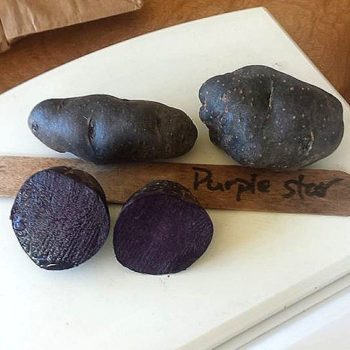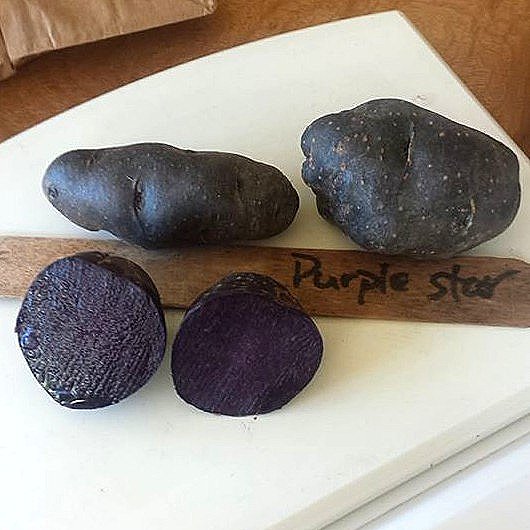Blog, potato (Solanum tuberosum)
‘Purple Star’ Potato Virus Cleanup Part 1: Initial Testing

Photo: Ellen Alley
This is the first of a series of short videos that will document the process of eliminating viruses from the ‘Purple Star’ potato variety. Purple Star was selected by Nathan Pierce of the Kenosha Potato Project in 2016 and has since shown the usual signs of running out due to virus burden. In this video, I discuss the most likely causes of the problem and do some testing to see if we can figure out the cause. Future videos will cover the process of establishing the variety in tissue culture, virus therapies, post-therapy testing, and hopefully a return to production.
Nathan has expressed interest in OSSI pledging this variety. Before it can be pledged, it has to be available to the public, so I plan to offer it in the catalog. Before I do that, I need to make sure that it is virus free. So, hopefully at the end of this process, we will have a new OSSI potato variety to offer.
If you prefer to read, a summary of the video follows:
Cleaning up potatoes is a process that can be divided in to five stages:
- Pre-therapy testing to determine which viruses the variety is infected with at the beginning
- Establishment of the variety in tissue culture
- Anti-viral therapies (thermotherapy, chemotherapy, and possibly electrotherapy)
- Post therapy testing to confirm that the viruses have been eliminated
- Propagation of clean, foundation seed tubers to re-establish the variety
This post covers the first stage.
I grew Purple Star in a small pot, until I had a plant about four inches tall. I then removed the top part of the plant with about six leaflets and then divided that into two portions. Each portion was crushed in a tissue homogenizing bag with an extraction buffer to produce a liquid mixture of plant tissue and cell contents. I then used four field test kits (Agdia Immunostrips) to test for the following viruses:
- Potato Virus S
- Potato Virus X
- Potato Virus Y
- Tobacco Mosaic Virus
- Tomato Spotted Wilt Virus
I don’t test for every possible virus in the initial testing. I test for these five viruses because the results help me to decide which methods to use to eliminate the viruses. Potato viruses S and X are a bit more difficult to treat than the other common viruses, so it helps me to know if they are present. Varieties infected with these viruses will undergo a longer course of therapy with both heat treatment and chemical (Ribavirin) treatment. Potato Virus Y is the most common virus I find when testing varieties. It isn’t the easiest virus to treat, but it is pretty straightforward to eliminate with meristem culture and thermotherapy. Tomato Spotted Wilt Virus is common in potatoes from private collections and it can actually be quite easy to treat, sometimes without even putting the plant in culture. Removing sprouts from the tuber and then growing them quickly under lights often produces a sprout in which the top part is virus free. It can be cut and rooted to get a clean plant some of the time. That is cheap and easy, so if a variety is only infected with TSWV, that is the first thing I will usually try. Tobacco Mosaic Virus is not particularly common in potatoes, but it is a major hazard that easily contaminates everything that it comes in contact with and can remain infectious for a long time. I put any plants with TMV in a more stringent quarantine to avoid spreading it.
I expected that Purple Star would probably be infected with multiple viruses, but the tests revealed good news: it was only infected with Potato Virus Y (of the viruses tested). That’s a pretty easy cleanup, so the prognosis is good for this variety. There will be a second round of testing later on though. It isn’t practical to test for every virus of concern at the beginning, so I will test for several more viruses after the first round of therapy and also send some samples off to a commercial lab to check for rarer but nasty viruses. Most likely, those tests will be negative.
Now that I know that it is infected with PVY, I went back and took a closer look at photos of this variety in the Kenosha Potato Project Facebook group. I suspect that this variety has been infected since either its seedling year or the year after, so it may show a substantial improvement in performance over even its initial results after cleanup. It will be interesting to see what happens!
We’ll move on to stage 2, establishing the variety in tissue culture, in three or four weeks, once the plant has grown about six inches tall and can provide at least six meristems. After that, the process could be completed in as little as six months. How long it takes will be determined by what we find in the second round of testing.


Any further development on this project since this post?